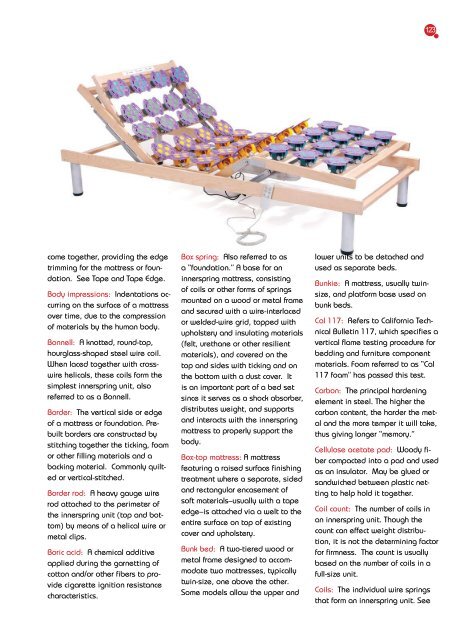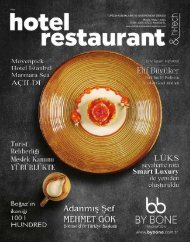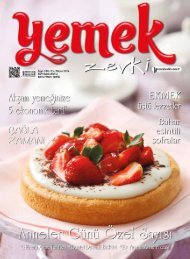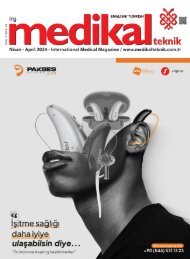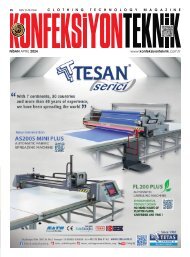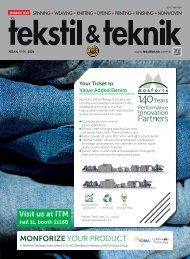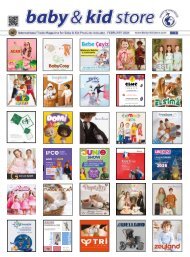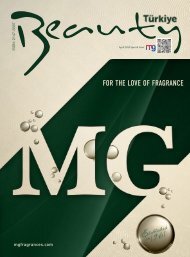SleepTech_January - February 2019
SleepTech_January - February 2019
SleepTech_January - February 2019
You also want an ePaper? Increase the reach of your titles
YUMPU automatically turns print PDFs into web optimized ePapers that Google loves.
123<br />
come together, providing the edge<br />
trimming for the mattress or foundation.<br />
See Tape and Tape Edge.<br />
Body impressions: Indentations occurring<br />
on the surface of a mattress<br />
over time, due to the compression<br />
of materials by the human body.<br />
Bonnell: A knotted, round-top,<br />
hourglass-shaped steel wire coil.<br />
When laced together with crosswire<br />
helicals, these coils form the<br />
simplest innerspring unit, also<br />
referred to as a Bonnell.<br />
Border: The vertical side or edge<br />
of a mattress or foundation. Prebuilt<br />
borders are constructed by<br />
stitching together the ticking, foam<br />
or other filling materials and a<br />
backing material. Commonly quilted<br />
or vertical-stitched.<br />
Border rod: A heavy gauge wire<br />
rod attached to the perimeter of<br />
the innerspring unit (top and bottom)<br />
by means of a helical wire or<br />
metal clips.<br />
Boric acid: A chemical additive<br />
applied during the garnetting of<br />
cotton and/or other fibers to provide<br />
cigarette ignition resistance<br />
characteristics.<br />
Box spring: Also referred to as<br />
a “foundation.” A base for an<br />
innerspring mattress, consisting<br />
of coils or other forms of springs<br />
mounted on a wood or metal frame<br />
and secured with a wire-interlaced<br />
or welded-wire grid, topped with<br />
upholstery and insulating materials<br />
(felt, urethane or other resilient<br />
materials), and covered on the<br />
top and sides with ticking and on<br />
the bottom with a dust cover. It<br />
is an important part of a bed set<br />
since it serves as a shock absorber,<br />
distributes weight, and supports<br />
and interacts with the innerspring<br />
mattress to properly support the<br />
body.<br />
Box-top mattress: A mattress<br />
featuring a raised surface finishing<br />
treatment where a separate, sided<br />
and rectangular encasement of<br />
soft materials–usually with a tape<br />
edge–is attached via a welt to the<br />
entire surface on top of existing<br />
cover and upholstery.<br />
Bunk bed: A two-tiered wood or<br />
metal frame designed to accommodate<br />
two mattresses, typically<br />
twin-size, one above the other.<br />
Some models allow the upper and<br />
lower units to be detached and<br />
used as separate beds.<br />
Bunkie: A mattress, usually twinsize,<br />
and platform base used on<br />
bunk beds.<br />
Cal 117: Refers to California Technical<br />
Bulletin 117, which specifies a<br />
vertical flame testing procedure for<br />
bedding and furniture component<br />
materials. Foam referred to as “Cal<br />
117 foam” has passed this test.<br />
Carbon: The principal hardening<br />
element in steel. The higher the<br />
carbon content, the harder the metal<br />
and the more temper it will take,<br />
thus giving longer “memory.”<br />
Cellulose acetate pad: Woody fiber<br />
compacted into a pad and used<br />
as an insulator. May be glued or<br />
sandwiched between plastic netting<br />
to help hold it together.<br />
Coil count: The number of coils in<br />
an innerspring unit. Though the<br />
count can effect weight distribution,<br />
it is not the determining factor<br />
for firmness. The count is usually<br />
based on the number of coils in a<br />
full-size unit.<br />
Coils: The individual wire springs<br />
that form an innerspring unit. See


